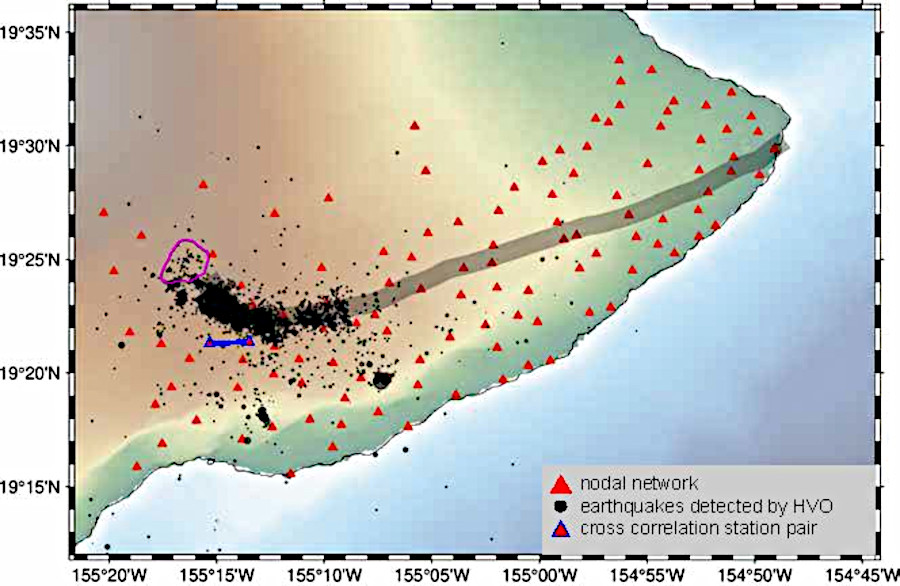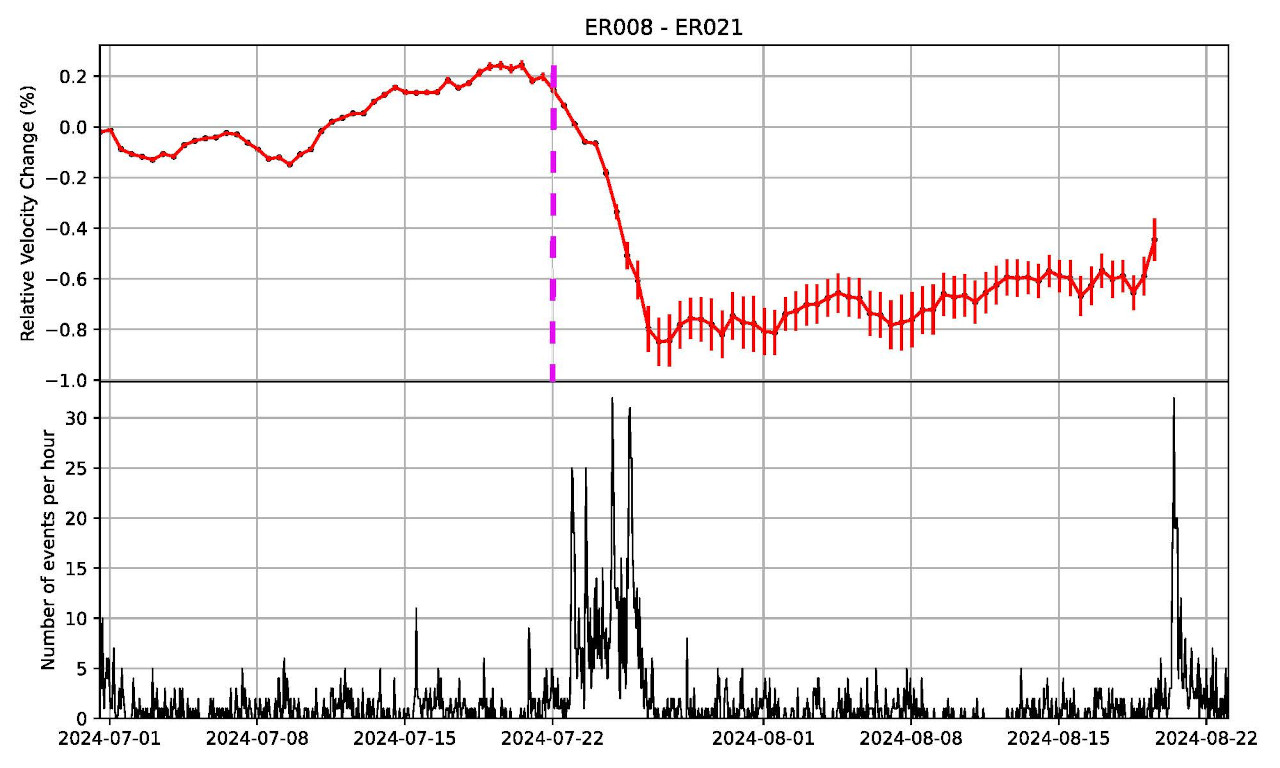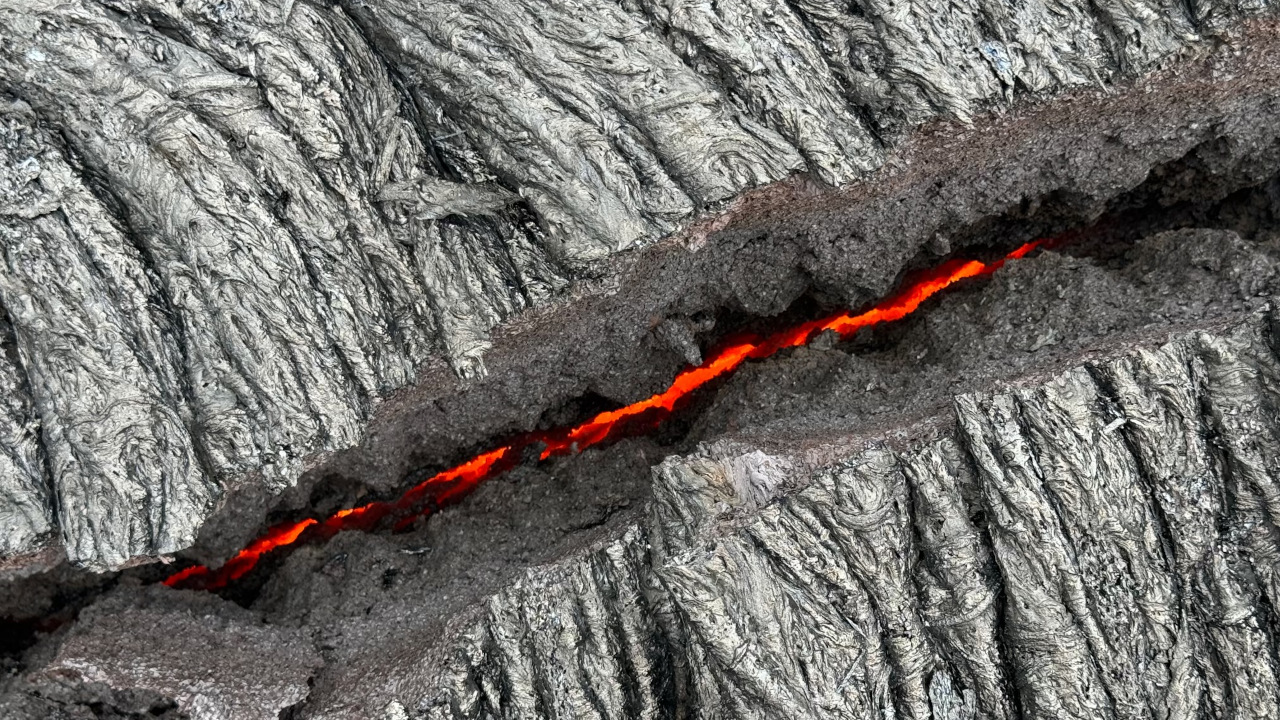(BIVN) – Kīlauea volcano is not eupting. The recent eruption at Nāpau Crater on the middle East Rift Zone has ended, and is not expected to restart. The USGS Volcano Alert Level for Kīlauea remans at ADVISORY.
In the latest Volcano Watch, scientists write about how they examine changes in seismic waves to understand magma storage and migration in the East Rift Zone.
This week’s article is written by HVO geophysicist Ninfa Bennington and colleagues from ETH Zürich, Federica Lanza and Alicia Rohnacher:
Kīlauea is one of the most active volcanoes in the world with eruptions common both at its summit caldera and within its two rift zones. Frequent earthquakes associated with volcanic activity can help us understand the magma structures below and the East Rift Zone (ERZ) of Kīlauea has proven to be a perfect laboratory recently.

USGS: “Map showing temporary seismic nodes across Kīlauea ERZ (red triangles). Earthquakes located in the ERZ between July 1, 2024, and September 22, 2024, are shown as black dots. Kaluapele (Kīlauea’s summit caldera) is outlined in magenta. The blue line drawn between two nodes indicates the area where the velocity changes in were calculated. Shaded grey area approximates the ERZ of Kīlauea.”
As signals created by earthquakes move through the ground, they are influenced by the structure of the volcano, including the presence of magma and/or fault zones. These structures can cause the seismic waves to travel faster or slower inside the Earth and are recorded on seismometers. Seismologists can take advantage of these changes, to create images of where magma is located and to track its path underground.
The USGS Hawaiian Volcano Observatory (HVO) has about 80 permanent seismometers on the Island of Hawaiʻi. Using only data from these permanent seismometers provides a fuzzy picture of underlying magma storage structures. However, if the number of seismometers at the surface is increased, more of the seismic waves traveling through regions of magma storage will be recorded yielding a crisper picture of the subsurface.
In late June 2024, seismologists from ETH Zürich and HVO deployed 115 seismic nodes (tiny, portably seismometers) across Kīlauea’s ERZ, fortuitously before significant unrest began in the ERZ. Data recorded on these nodes will be used to image the location and volume of magma within the ERZ at a level of detail not previously possible, and the resulting model will help us to better understand the volcanic hazards in this region.
These densely spaced seismic instruments will continue to record seismic signals through October 2024. Given the timeline of their occupation, they recorded earthquakes associated with intrusions of magma into the ERZ in July and August, as well as the September 15–20 eruption in the middle ERZ. In fact, four of the nodes had to be rescued from the field to prevent them from being impacted by the recent eruption.

USGS: “Changes in seismic velocity and earthquake rates at Kīlauea from July to mid-August 2024. Changes in seismic velocity with time are shown in the top panel. The bottom panel shows earthquake rates with time for the same period. The dashed magenta line indicates the opening of cracks and fractures as the magmatic intrusion began in the ERZ. The continued decrease in seismic velocity seen to the right of the magenta line reflects continued intrusion of magma into the region.”
While the dense seismic array continues to record data, scientists have collected a subset of data from these instruments including late June through late August 2024. ETH and HVO seismologists are working together to analyze these newly collected data. Specifically, they are using an analysis tool called ambient noise interferometry—which takes advantage of continuous seismic signals created through the interaction between ocean swells and the ocean crust—to identify what was happening below the surface leading to the September eruption.
Magma moving through a volcano opens and closes fracture systems causing changes in the speed that ocean noise signals travel through the ground. Scientists can monitor these ocean noise signals for signs that magma is accumulating beneath the surface.
Ocean noise traveling through the ground below the upper ERZ of Kīlauea volcano between early July and late August 2024 showed changes as magma began to enter this area. The most dramatic change we observe is a rapid velocity decrease that begins on July 21, indicating the opening of cracks and fractures due to magmatic intrusions in this region. At the same time, swarms of earthquakes were occurring due to stresses created from intrusion of magma into the subsurface.
This example shows how ambient noise interferometry, along with other volcano monitoring datasets, can be used to understand the changes occurring beneath the surface of a volcano. While this example focuses on changes in velocity at a single pair of nodes, future analysis will be carried out for the entire 115 instrument array, which spans Kīlauea’s ERZ. This complete analysis will contribute to our understanding of where magma migrated across the ERZ in the time leading to the September 2024 eruption.


by Big Island Video News8:02 am
on at
STORY SUMMARY
ISLAND OF HAWAIʻI - Seismologists use the changes in seismic waves as the waves travel through the volcano to create images of where magma is located, and to track its path underground.